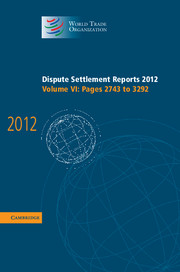Book contents
- Frontmatter
- TABLE OF CONTENTS
- Contents
- TABLE OF WTO AND GATT CASES CITED IN THIS REPORT
- TABLE OF ABBREVIATIONS
- I INTRODUCTION
- II FACTUAL ASPECTS
- III PARTIES' REQUESTS FOR FINDINGS AND RECOMMENDATIONS
- IV ARGUMENTS OF THE PARTIES
- V ARGUMENTS OF THE THIRD PARTIES
- VI INTERIM REVIEW
- VII FINDINGS
- VIII FINDINGS AND RECOMMENDATIONS
- ANNEX A EXECUTIVE SUMMARIES OF THE FIRST WRITTEN SUBMISSIONS OF THE PARTIES
- ANNEX B EXECUTIVE SUMMARIES OF THE SECOND WRITTEN SUBMISSIONS OF THE PARTIES
- ANNEX C THIRD PARTY SUBMISSIONS
- ANNEX D ORAL STATEMENTS OF THE PARTIES AT THE FIRST AND SECOND SUBSTANTIVE MEETINGS
- ANNEX E WORKING PROCEDURES FOR THE PANEL
- ANNEX F PROCEDURES FOR OPEN HEARINGS
- Cumulative List of Published Disputes
II - FACTUAL ASPECTS
Published online by Cambridge University Press: 12 December 2017
- Frontmatter
- TABLE OF CONTENTS
- Contents
- TABLE OF WTO AND GATT CASES CITED IN THIS REPORT
- TABLE OF ABBREVIATIONS
- I INTRODUCTION
- II FACTUAL ASPECTS
- III PARTIES' REQUESTS FOR FINDINGS AND RECOMMENDATIONS
- IV ARGUMENTS OF THE PARTIES
- V ARGUMENTS OF THE THIRD PARTIES
- VI INTERIM REVIEW
- VII FINDINGS
- VIII FINDINGS AND RECOMMENDATIONS
- ANNEX A EXECUTIVE SUMMARIES OF THE FIRST WRITTEN SUBMISSIONS OF THE PARTIES
- ANNEX B EXECUTIVE SUMMARIES OF THE SECOND WRITTEN SUBMISSIONS OF THE PARTIES
- ANNEX C THIRD PARTY SUBMISSIONS
- ANNEX D ORAL STATEMENTS OF THE PARTIES AT THE FIRST AND SECOND SUBSTANTIVE MEETINGS
- ANNEX E WORKING PROCEDURES FOR THE PANEL
- ANNEX F PROCEDURES FOR OPEN HEARINGS
- Cumulative List of Published Disputes
Summary
Measures at Issue
2.1 The claims brought by Canada and Mexico concern the United States' country of origin labelling (COOL) requirements for meat products.
2.2 Canada submits that the COOL measure consists of the following provisions:
(a) the Agricultural Marketing Act of 1946, as amended by the Farm Security and Rural Investment Act of 2002 (“2002 Farm Bill”) and the Food, Conservation, and Energy Act of 2008 (“2008 Farm Bill”);
(b) the Interim Final Rule on Mandatory Country of Origin Labelling of Beef, Pork, Lamb, Chicken, Goat Meat, Perishable Agricultural Commodities, Peanuts, Pecans, Ginseng, and Macadamia Nuts, published on 1 August 2008 as 7 CFR Part 65 (“Interim Final Rule (AMS)”) and on Mandatory Country of Origin Labelling of Muscle Cuts of Beef (including Veal), Lamb, Chicken, Goat, and Pork, Ground Beef, Ground Lamb, Ground Chicken, Ground Goat, and Ground Pork, published on 28 August 2008 as 9 CFR Parts 317 and 381 (“Interim Final Rule (FSIS)”);
(c) the Final Rule on Mandatory Country of Origin Labelling of Beef, Pork, Lamb, Chicken, Goat Meat, Perishable Agricultural Commodities, Peanuts, Pecans, Ginseng, and Macadamia Nuts, published on 15 January 2009 as 7 CFR Part 65 (the “2009 Final Rule (AMS)”);
(d) the letter to “Industry Representative” from the United States Secretary of Agriculture, Thomas J. Vilsack, of 20 February 2009 (the “Vilsack letter”); and
(e) any modifications, administrative guidance, directives or policy announcements issued in relation to items (a) through (d) above.
- Type
- Chapter
- Information
- Dispute Settlement Reports 2012 , pp. 2765 - 2769Publisher: Cambridge University PressPrint publication year: 2014

